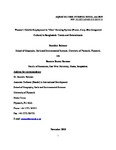Women’s gainful employment in ‘gher’ farming system (prawn–carp–rice integrated culture) in Bangladesh: trends and determinants
| dc.contributor.author | Rahman, S | |
| dc.contributor.author | Barmon, BK | |
| dc.date.accessioned | 2019-03-28T10:46:02Z | |
| dc.date.issued | 2019-04 | |
| dc.identifier.issn | 0967-6120 | |
| dc.identifier.issn | 1573-143X | |
| dc.identifier.uri | http://hdl.handle.net/10026.1/13562 | |
| dc.description.abstract |
© 2019, Springer Nature Switzerland AG. The paper examines trends in women’s gainful employment in ‘prawn-carp’ and ‘high yield variety (HYV) rice’ enterprises of the ‘gher’ farming system and jointly identifies the determinants of employing female and male labor in these enterprises using a farm-level panel data of 90 producers covering a 14-year period (2002–2015) from southwest Bangladesh by applying a multivariate Tobit approach. Results revealed that women’s gainful employment and real wage increased significantly with a substantial reduction in wage gap between female and male labor. The decision to employ female and male labor was found to be positively correlated thereby confirming jointness in decision-making and validity of our chosen approach. Prices and socio-economic factors exerted varied influences on female and male labor demand. Output prices, cultivated area, education, and experience positively increased women’s gainful employment whereas larger family size reduced it. Policy implications include investments in education targeted at the ‘gher’ farming households and land reform policies to consolidate farm size and facilitate smooth functioning of the land market to increase women’s gainful employment. | |
| dc.format.extent | 519-537 | |
| dc.format.medium | Undetermined | |
| dc.language | en | |
| dc.language.iso | en | |
| dc.publisher | Springer Verlag | |
| dc.subject | Women's gainful employment | |
| dc.subject | "Gher' farming system | |
| dc.subject | Socio-economic determinants | |
| dc.subject | Multivariate Tobit model | |
| dc.subject | Bangladesh | |
| dc.title | Women’s gainful employment in ‘gher’ farming system (prawn–carp–rice integrated culture) in Bangladesh: trends and determinants | |
| dc.type | journal-article | |
| dc.type | Article | |
| plymouth.author-url | https://www.webofscience.com/api/gateway?GWVersion=2&SrcApp=PARTNER_APP&SrcAuth=LinksAMR&KeyUT=WOS:000461393000013&DestLinkType=FullRecord&DestApp=ALL_WOS&UsrCustomerID=11bb513d99f797142bcfeffcc58ea008 | |
| plymouth.issue | 2 | |
| plymouth.volume | 27 | |
| plymouth.publisher-url | http://dx.doi.org/10.1007/s10499-019-00347-9 | |
| plymouth.publication-status | Published | |
| plymouth.journal | Aquaculture International | |
| dc.identifier.doi | 10.1007/s10499-019-00347-9 | |
| plymouth.organisational-group | /Plymouth | |
| plymouth.organisational-group | /Plymouth/Faculty of Arts, Humanities and Business | |
| plymouth.organisational-group | /Plymouth/Users by role | |
| dcterms.dateAccepted | 2019-01-17 | |
| dc.rights.embargodate | 2020-1-28 | |
| dc.identifier.eissn | 1573-143X | |
| dc.rights.embargoperiod | Not known | |
| rioxxterms.versionofrecord | 10.1007/s10499-019-00347-9 | |
| rioxxterms.licenseref.uri | http://www.rioxx.net/licenses/all-rights-reserved | |
| rioxxterms.licenseref.startdate | 2019-04 | |
| rioxxterms.type | Journal Article/Review |


